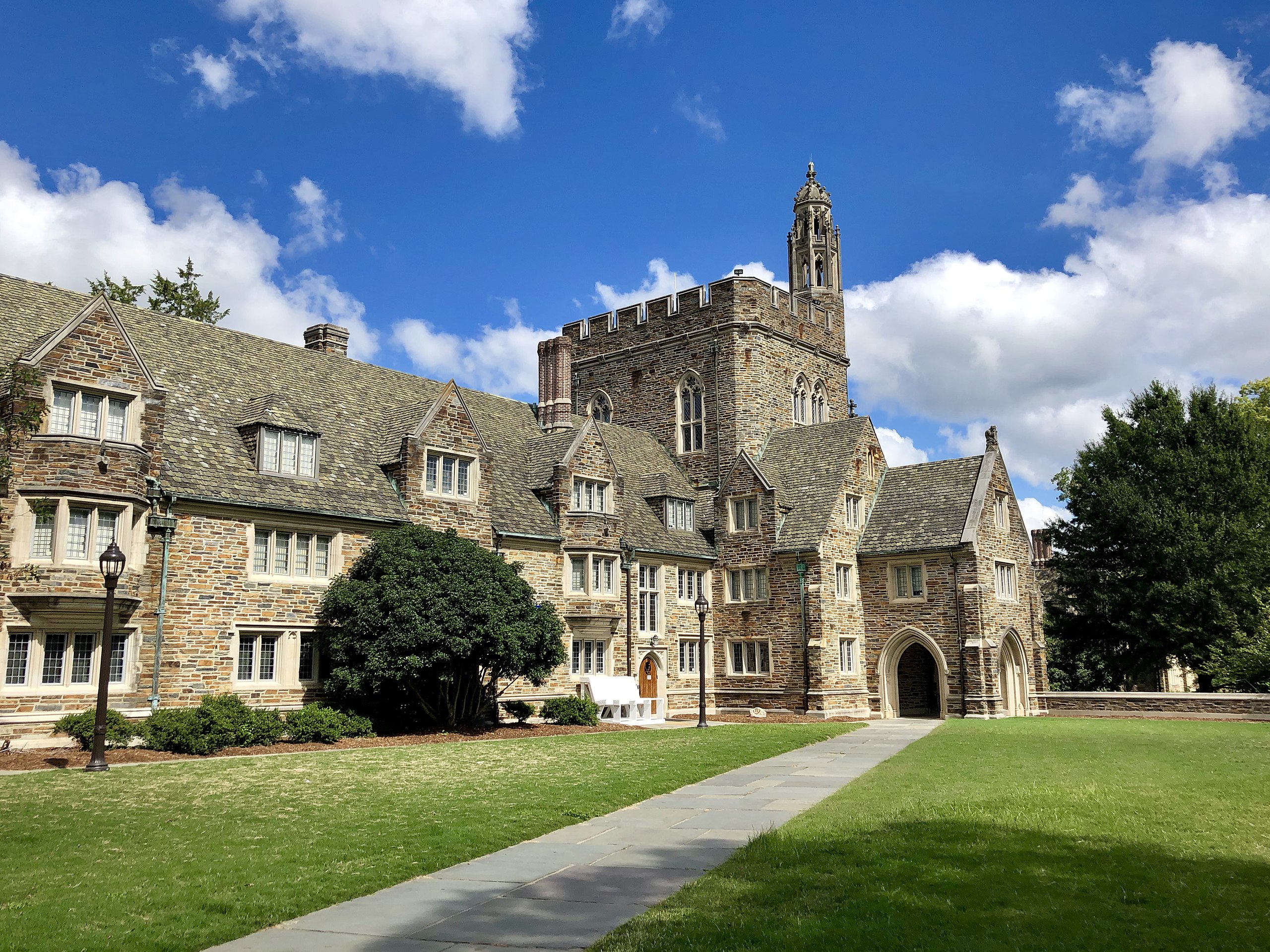| School |
First-Year Acceptance Rate |
Transfer Acceptance Rate |
| American University |
61.87% |
82.61% |
| Amherst College |
9.01% |
8.62% |
| Arizona State University |
Overall: 89.89%
In-state: 91.62%
Out-of-state: 89.17%
International: 89.63% |
90.66% |
| Auburn University |
45.92% |
51.67% |
| Babson College |
17.09% |
23.20% |
| Bates College |
13.30% |
9.57% |
| Baylor University |
51.28% |
88.29% |
| Belmont University |
95.28% |
92.31% |
| Bentley University |
45.05% |
43.76% |
| Binghamton University |
Overall: 38.61%
In-state: 31.32%
Out-of-state: 79.18%
International: 65.44% |
45.23% |
| Boston University |
11.11% |
34.60% |
| Bowdoin College |
7.13% |
8.63% |
Brandeis University
|
40.47% |
49.40% |
| Brown University |
5.39% |
7.20% |
| Bryn Mawr College |
29.43% |
13.89% |
| Bucknell University |
28.93% |
20.60% |
California Institute of Technology
|
2.57% |
6.18% |
| Carleton College |
20.41% |
16.11% |
| Carnegie Mellon University |
11.66% |
5.57% |
| Case Western Reserve University |
37.78% |
23.98% |
| Chapman University |
65.43% |
60.79% |
| Claremont McKenna College |
9.59% |
5.67% |
| Clark University |
39.54% |
21.21% |
| Clemson University |
Overall: 38.34%
In-state: 55.95%
Out-of-state: 34.94%
International: 35.77% |
58.46% |
| Colgate University |
13.88% |
9.62% |
| College of Charleston |
Overall: 60.03%
In-state: 73.94%
Out-of-state: 55.76%
International: 54.44% |
93.03% |
| College of William and Mary |
34.00% |
50.12% |
| Colorado College |
18.47% |
31.89% |
| Columbia University |
3.86% |
8.97% |
| Connecticut College |
37.04% |
32.14% |
| Cornell University |
8.41% |
9.28% |
| Dartmouth College |
5.40% |
6.65% |
| Davidson College |
13.37% |
17.11% |
| DePaul University |
75.89% |
62.92% |
| Dickinson College |
42.09% |
25.36% |
| Drexel University |
79.44% |
60.33% |
| Duke University |
5.40% |
3.00% |
| Elon University |
66.35% |
56.18% |
| Emory University |
Emory campus: 10.29% |
Emory campus: 16.20% |
| Fairfield University |
33.29% |
9.65% |
| Florida State University |
Overall: 24.22%
In-state: 31.85%
Out-of-state: 16.58%
International: 10.55% |
30.78% |
| Furman University |
42.95% |
23.12% |
| George Washington University |
47.09% |
61.88% |
| Georgetown University |
12.91% |
5.93% |
| Georgia Tech |
Overall: 14.07%
In-state: 33.13%
Out-of-state: 10.42%
International: 8.20% |
20.67% |
| Gonzaga University |
81.69% |
70.75% |
| Grinnell College |
14.51% |
18.89% |
| Hamilton College |
13.62% |
12.41% |
| Harvard University |
3.65% |
0.71% |
| Harvey Mudd College |
12.66% |
7.53% |
| Haverford College |
12.37% |
12.37% |
| Howard University |
41.34% |
77.03% |
| Indiana University |
Overall: 78.21%
In-state: 75.14%
Out-of-state: 80.76%
International: 66.82% |
65.09% |
| Johns Hopkins University |
6.44% |
5.27% |
| Kenyon College |
31.03% |
46.60% |
| Lafayette College |
31.45% |
21.16% |
| Lehigh University |
25.93% |
24.41% |
| Lewis & Clark College |
78.49% |
58.80% |
| Loyola Marymount University |
45.08% |
47.88% |
| Loyola University Chicago |
81.60% |
51.78% |
| Macalester College |
28.52% |
28.65% |
| Marquette University |
81.34% |
69.11% |
| Michigan State University |
Overall: 84.80%
In-state: 84.36%
Out-of-state: 84.37%
International: 88.10% |
77.90% |
| Middlebury College |
10.75% |
8.36% |
| Montana State University |
Overall: 82.14%
In-state: 86.21%
Out-of-state: 80.99%
International: 91.78% |
89.87% |
| New York University |
9.23% |
22.09% |
| North Carolina State University |
Overall: 41.67%
In-state: 49.56%
Out-of-state: 35.71%
International: 22.87% |
Overall: 47.10%
In-state: 58.48%
Out-of-state and international: 27.55% |
| Northeastern University |
5.22% |
19.74% |
| Oberlin College |
Overall: 34.16%
College of Arts & Sciences: 34.30%
Conservatory: ~33.09% |
26.56% |
| Occidental College |
44.17% |
32.81% |
| Pace University |
75.92% |
55.70% |
| Pennsylvania State University |
Overall: 60.56%
In-state: 62.51%
Out-of-state: 59.08%
International: 64.37% |
69.79% |
| Pepperdine University |
62.86% |
43.75% |
| Pitzer College |
25.16% |
27.57% |
| Pomona College |
7.09% |
8.64% |
| Princeton University |
4.62% |
1.91% |
| Providence College |
50.89% |
47.81% |
| Purdue University |
Overall: 49.79%
In-state: 74.17%
Out-of-state: 50.70%
International: 27.56% |
51.55% |
| Reed College |
24.61% |
20.06% |
| Rensselaer Polytechnic Institute |
63.43% |
58.20% |
| Rice University |
8.00% |
6.92% |
Rochester Institute of Technology
|
66.98% |
41.03% |
| Rose-Hulman Institute of Technology |
76.86% |
69.12% |
| San Diego State University |
Overall: 35.98%
In-state: 30.79%
Out-of-state: 87.06%
International: 57.06% |
53.47% |
| Santa Clara University |
48.00% |
52.35% |
| Scripps College |
38.29% |
14.10% |
| Skidmore College |
21.05% |
39.34% |
| Smith College |
21.00% |
20.63% |
| Southern Methodist University |
63.35% |
74.96% |
| Stanford University |
3.61% |
1.58% |
| Stony Brook University |
Overall: 49.04%
In-state: 41.57%
Out-of-state: 61.68%
International: 73.08% |
49.36% |
| Swarthmore College |
7.46% |
0.00% (because of space concerns) |
| Texas A&M |
Overall: 57.32%
In-state: 59.02%
Out-of-state: 48.71%
International: 56.53% |
48.88% |
| Texas Christian University |
44.49% |
81.11% |
| Texas Tech |
Overall: 72.65%
In-state: 74.82%
Out-of-state: 68.25%
International: 33.65% |
76.92% |
| Trinity University |
25.92% |
34.90% |
| Tufts University |
11.53% |
21.24% |
| Tulane University |
13.98% |
60.07% |
| University at Albany |
Overall: 69.09%
In-state: 68.48%
Out-of-state: 82.36%
International: 55.13% |
54.13% |
| University at Buffalo |
Overall: 74.18%
In-state: 76.16%
Out-of-state: 78.99%
International: 60.43% |
64.73% |
| University of California, Berkeley |
Overall: 11.04%
In-state: 14.93%
Out-of-state: 7.34%
International: 3.38% |
Overall: 22.27%
In-state: 24.63%
Out-of-state: 6.3%
International: 11.47% |
| University of California, Davis |
Overall: 41.83%
In-state: 36.55%
Out-of-state: 57.32%
International: 50.68% |
Overall: 58.17%
In-state: 59.51%
Out-of-state: 25.19%
International: 55.75% |
| University of California, Irvine |
Overall: 28.78%
In-state: 21.82%
Out-of-state: 49.76%
International: 43.14% |
Overall: 39.93%
In-state: 39.44%
Out-of-state: 13.46%
International: 44.16% |
| University of California, Los Angeles |
Overall: 8.97%
In-state: 9.53%
Out-of-state: 9.26%
International: 6.26% |
Overall: 22.73%
In-state: 24.02%
Out-of-state: 6.52%
International: 17.00% |
| University of California, San Diego |
Overall: 26.77%
In-state: 25.99%
Out-of-state: 33.49%
International: 22.44% |
Overall: 54.55%
In-state: 54.75%
Out-of-state: 22.26%
International: 57.04% |
| University of California, Santa Barbara |
Overall: 32.96%
In-state: 32.38%
Out-of-state and international: 38.21% |
Overall: 61.66%
In-state: 62.93%
Out-of-state: 23.40%
International: 59.89% |
| University of California, Santa Cruz |
Overall: 65.57%
In-state: 62.15%
Out-of-state: 81.41%
International: 77.06% |
Overall: 63.78%
In-state: 65.28%
Out-of-state: 19.87%
International: 58.96% |
| University of Colorado – Boulder |
Overall: 76.21%
In-state: 84.84%
Out-of-state: 72.88%
International: 81.54% |
71.98% |
| University of Denver |
77.29% |
80.36% |
| University of Florida |
Overall: 24.20%
In-state: 23.26%
Out-of-state: 23.82%
International: 32.49% |
44.86% |
University of Illinois, Urbana-Champaign
|
Overall: 42.37%
In-state: 54.39%
Out-of-state: 36.20%
International: 33.52% |
48.08% |
| University of Maryland |
Overall: 59.73%
In-state: 60.47%
Out-of-state: 60.95%
International: 52.86% |
64.49% |
| University of Massachusetts – Amherst |
Overall: 59.73%
In-state: 60.47%
Out-of-state: 60.95%
International: 52.86% |
64.49% |
| University of Miami |
18.90% |
53.40% |
| University of Michigan |
15.64% |
34.91% |
| University of North Carolina at Charlotte |
Overall: 79.60%
In-state: 84.38%
Out-of-state: 67.38%
International: 73.95% |
Overall: 88.40%
In-state: 92.11%
Out-of-state and international: 77.92% |
| University of North Carolina at Chapel Hill |
Overall: 15.34%
In-state: 37.99%
Out-of-state: 6.63%
International: 14.28% |
Overall: 36.39%
In-state: 46.96%
Out-of-state and international: 29.10% |
| University of Notre Dame |
11.27% |
25.09% |
| University of Pennsylvania |
5.40% |
3.21% |
| University of Pittsburgh |
58.08% |
45.17% |
| University of Richmond |
22.20% |
45.58% |
| University of Rochester |
Overall: 40.08%
College of Arts, Sciences and Engineering: 40.13%
Eastman School of Music: 39.00% |
Overall: 38.60%
College of Arts, Sciences and Engineering: 38.10%
Eastman School of Music: 44.83% |
| University of San Diego |
52.38% |
66.51% |
| University of South Carolina |
Overall: 60.15%
In-state: 76.17%
Out-of-state: 54.72%
International: 65.32% |
66.13% |
| University of Southern California |
9.81% |
21.61% |
University of Tennessee, Knoxville
|
Overall: 41.60%
In-state: 70.10%
Out-of-state: 33.37%
International: 28.59% |
56.68% |
| University of Texas at Austin |
Overall: 26.64%
In-state: 37.72%
Out-of-state: 10.13%
International: 12.87% |
22.55% |
| University of Vermont |
Overall: 65,30%
In-state: 74.15%
Out-of-state: 65.68%
International: 34.91% |
80.92% |
| University of Virginia |
In-state: 25.93%
Out-of-state: 13.83%
International: 10.46% |
In-state: 40.00%
Out-of-state: 20.00%
Virginia Community College System (including Guaranteed Admission Applications): 52.00% |
| University of Washington – Seattle |
Overall: 39.15%
In-state: 47.85%
Out-of-state: 36.20%
International: 38.83% |
43.76% |
| University of Wisconsin – Madison |
Overall: 45.17%
In-state: 59.27%
Out-of-state: 46.45%
International: 33.26% |
55.51% |
| Vanderbilt University |
5.86% |
21.80% |
| Vassar College |
18.57% |
10.22% |
| Virginia Tech |
Overall: 54.99%
In-state: 47.65%
Out-of-state: 59.06%
International: 66.04% |
50.98% |
| Washington & Lee University |
13.97% |
5.63% |
Washington University in St. Louis
|
12.06% |
14.01% |
| Wellesley College |
14.05% |
9.59% |
| Wesleyan University |
16.49% |
24.13% |
| Williams College |
8.25% |
2.76% |
| Worcester Polytechnic Institute |
60.16% |
64.71% |
| Yale University |
3.87% |
1.46% |




